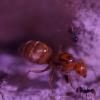I found this queen off of highway 50 coming home from Tahoe yesterday around Pollock Pines, California. I need a positive identification on her please. size is around 10mm I think.
Edited by jeffpbalderston, April 12 2015 - 12:59 AM.


Best Answer jeffpbalderston , April 12 2015 - 11:50 AM
Aha! After further research I finally came across with 6 specimens of this species found in the Sierras! Thank you very much Dr.Trager!I just hope now she is fertile.
Go to the full post 
This is something in the rufa-group. The strongly keeled clypeus with un-notched margin is unlike the clypeus shape of any sanguinea-group species. This might be the fairly common F. integroides.
Edited by jeffpbalderston, April 12 2015 - 11:28 AM.
Edited by jeffpbalderston, April 12 2015 - 11:50 AM.
I think the ants in the rufa-group are also parasitic. You might have to boost her with some pupae.
I see. Thanks Jonathan. Ill just have to wait for F. moki I suppose?
BTW you can mark this thread as solved.
I just hope now she is fertile.
Yeah... that's what I'm kind of wondering. Let's hope you get lucky.
0 members, 1 guests, 0 anonymous users